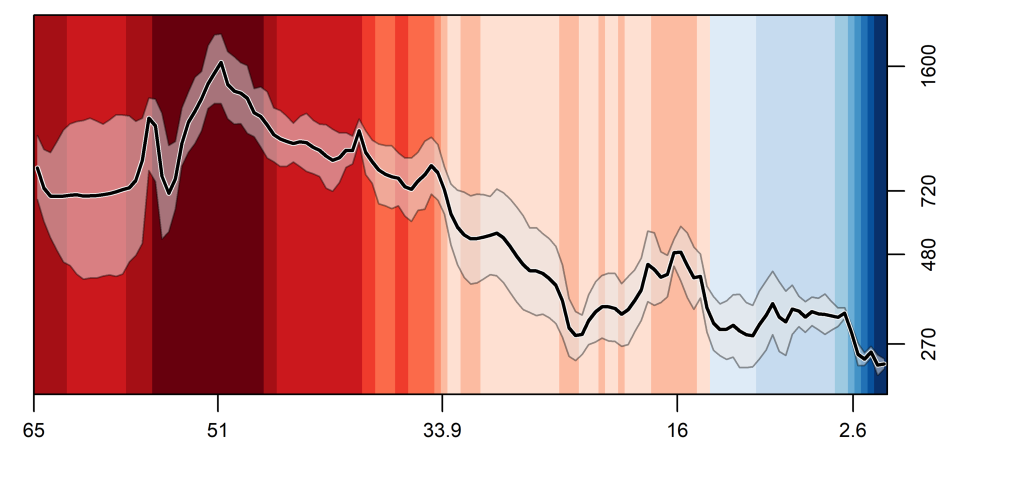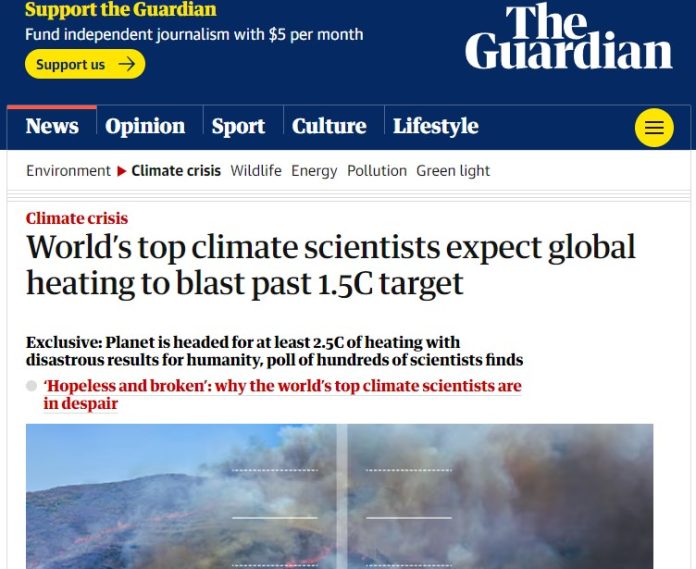A recent article in the newspaper The Guardian reports that some of the ”world’s top climate scientists” believe that disaster is soon to occur due to what they claim will be an additional degree of warming on the planet. This is a false narrative. The earth has experienced similar temperatures in the past without disastrous consequences. In addition, one should note that opinion when it comes to climate science has had a terrible track record.
The opinion piece, titled “World’s top climate scientists expect global heating to blast past 1.5C target,” starts off with gloom and doom in the first couple of paragraphs:
Almost 80% of the respondents, all from the authoritative Intergovernmental Panel on Climate Change (IPCC), foresee at least 2.5C of global heating, while almost half anticipate at least 3C (5.4F). Only 6% thought the internationally agreed 1.5C (2.7F) limit would be met.
Many of the scientists envisage a “semi-dystopian” future, with famines, conflicts, and mass migration, driven by heatwaves, wildfires, floods, and storms of an intensity and frequency far beyond those that have already struck.
First, as Climate Realism has previously discussed, here, for instance, the 1.5°C so-called limit is an arbitrarily made-up threshold. There is no scientific evidence that surpassing the 1.5℃ politically established amount of warming will result in worsening extreme weather events. What’s true of the 1.5℃ threshold is equally true of the 2°C limit, as Roger Pielke Jr., Ph.D. explains in his article, The Two Degree Temperature Target is Arbitrary and Untethered.
In The Guardian article, the opinion of “climate experts” suggests that disasters are afoot, with experts telling the paper that “massive preparations to protect people from the worst of the coming climate disasters were now critical.”
Leticia Cotrim da Cunha, at the State University of Rio de Janeiro, said: “I am extremely worried about the costs in human lives.”
“I am convinced that we have all the solutions needed for a 1.5C path and that we will implement them in the coming 20 years,” said Henry Neufeldt, at the U.N.’s Copenhagen Climate Centre. “But I fear that our actions might come too late and we cross one or several tipping points.”
What’s ironic, is that both The Guardian and those “climate experts” have missed the fact that in Europe, both the 1.5° and 2°C “limits” have already been surpassed, with no deleterious effects.
Below in Figure 1 is the Berkeley Earth average surface temperature record for Europe since about 1780. Europe is a good location to analyze, because some of the longest continuous temperature records are from Europe. It shows that not just 1.5°C, but 2.0°C of warming has already occurred.

Claims that reaching such temperatures supposedly driven by increased carbon dioxide (CO2) in the Earth’s atmosphere are causing or will cause disasters, such as climate tipping points, have been repeatedly debunked at Climate Realism, not a single one of those predictions has come true.
Also, Cotrim da Cunha’s stated worry that warming will result in more humans dying is belied by the fact that research shows that 10 to 17 time more people die of cold than heat, and that as the Earth has warmed the number of people dying from temperature related illnesses has fallen dramatically.
Given that track record, it hardly seems likely that some additional warming will result in disasters. According to a 2023 study by the University of California Santa Cruz, Earth has experienced higher CO2 levels and warmer temperature in the past, as seen in Figure 2 below:

Earth survived, and history shows that humans are highly adaptable, thus the alarm over missing some arbitrary climate target temperatures we’ve already reached is both unjustified and moot.
What we have here is nothing more than an opinion poll of people whose entire careers are built upon hyping climate catastrophe, whose and reputations will be destroyed if the climate crisis narrative is untrue.
Scientific thinking and practice involves forming testable hypotheses, deciding how to test those hypotheses, doing the tests and analyzing the results to formulate proof and test theory. The claims of climate catastrophes, when they have been tested by experience and time, have proven false. And the future disastrous climate scenarios the experts are forecasting can’t be confirmed outside of the climate models that the self-same experts reference and rely upon to for their opinions. Opinion about science is not science at all but a belief.
This Guardian article is not news, but rather simply gives voice to so-called “experts,” whose past claims about the future are one long train of failed predictions. The Guardian has proven time and again that when it comes to “reporting” on climate change, it and its writers are shameless promoters of the climate crisis narrative which has no basis in evidence or data.


















The Earth is still in a 2.5 million-year ice age named the Quaternary Glaciation with 90 percent of the fresh water locked up in ice caps and 200,000 glaciers. Outside of the tropics everyone that can lives in heated houses and apartment, drives heated cars, works in heated building and wears warm clothes most of the year.
People live in cold temperature like Anchorage Alaska at around 20F(-7C) in January to Dubai at around 97F(36C) in July. Different people like different temperatures to live in, some like it warm, some like it cool.
Around 4.6 million people die every year from cold-related causes compared to about 500,000 people that die from heat-relate causes. https://www.thelancet.com/journals/lanplh/article/PIIS2542-5196(21)00081-4/fulltext.
CO2 dropped to 180 ppm in the last glacial period, at 150 ppm most land plants die from the failure of photosynthesis taking most land animals down with them. The next glacial period will start at any time.
https://pioga.org/just-the-facts-more-co2-is-good-less-is-bad
The Grand Solar Minimum that has started may be the trigger.
‘Modern Grand Solar Minimum will lead to terrestrial cooling’
https://www.tandfonline.com/doi/pdf/10.1080/23328940.2020.1796243?needAccess=true
The cost is astronomical. Bloomberg’s green energy research team estimate $US200 trillion to stop warming by 2050. There are about 2 million household worldwide, so that is $100,000 per household. Probably only 10 percent of household can afford anything additional so that will be $1 million per household. Given the choice almost all household would prefer $1 million in the bank and a degree or two of warming.
https://www.bloomberg.com/opinion/articles/2023-07-05/-200-trillion-is-needed-to-stop-global-warming-that-s-a-bargain